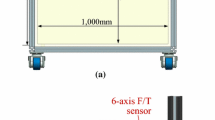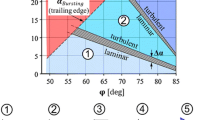Abstract
An unsteady flow visualization and force measurement were carried out in order to investigate the effects of the reduced frequency of a dragonfly-type model. The flow visualization of the wing wake region was conducted by using a smoke-wire technique. An electronic device was mounted below the test section in order to find the exact position angle of the wing for the visualization. A load-cell was employed in measuring aerodynamic forces generated by a plunging motion of the experimental model. To find the period of the flapping motion in real time, trigger signals were also collected by passing laser beam signals through the gear hole. Experimental conditions were as follows: the incidence angles of the foreand hind-wing were 0° and 10°, respectively, and the reduced frequencies were 0.150 and 0.225. The freestream velocities of the flow visualization and force measurement were 1.0 and 1.6m/sec, respectively, which correspond to Reynolds numbers of 3.4 × 103 and 2.9 × 103. The variations of the flow patterns and phase-averaged lift and the thrust coefficients during one cycle of the wing motion were presented. Results showed that the reduced frequency was closely related to the flow pattern that determined flight efficiency, and the maximum lift coefficient and lift coefficient per unit of time increased with reduced frequency.
Similar content being viewed by others
References
Alexander, D. E., Studies on Flight Control and Aerodynamics in Dragonflies, (1982), Ph. D. Dissertation, Duke Unversity, Durham, NC.
Chang, J. W. and Sohn, M. H., Numerical Flow Visualization of First Cycle and Cyclic Motion of a Rigid Fling-Clapping Wing, Journal of Visualization, 9-4 (2006), 381–391.
Chasman, D. and Chakravarthy, S., Computational and Experimental Studies of Asymmetric Pitch/Plunge Flapping-The Secret of Biological flyers, AIAA paper 2001-0859, (2001).
Corke, T., Koga, D., Drubka, R. and Nabib, H., A New Technique for Introducing Controlled Sheets of Smoke Streaklines in Wind Tunnels, Proceedings of International Congress on Instrumentation in Aerospace Simulation Facilities, (1974), 74-80.
Dickinson, M. H. and Gotz, K. D., Unsteady aerodynamic performance of model wings at low Reynolds number, Journal of Experimental Biology, 174 (1993), 45–64.
Fejtek, I. and Nehera, J., Experimental study of flapping wing lift and propulsion, Journal of Aeronautical, 84 (1980), 28–33.
Liu, H., Ellington, C. P., Kawachi, K., Van den berg, C. and Willmott, A. P., A computational fluid dynamic study of hawkmoth hovering, Journal of Experimental Biology, 201 (1998), 461–477.
Okamoto, M., Yasuda, K. and Azuma, A., Aerodynamic Characteristics of the Wings and Body of a Dragonfly, Journal of Experimental Biology, 199 (1996), 281–294.
Saharon, D. and Luttges, M. W., Visualization of Unsteady Separated Flow Produced by Mechanically Driven Dragonfly Wing Kinematics Model, AIAA Paper 88-0569, (1988).
Singh, B., Ramasamy, M., Chopra, I. and Leishman, J. G., Insect-based flapping wings for micro hovering air vehicle: experimental investigations, American helicopter society international specialists meeting, (2004).
Van den Berg, C. and Ellington, C. P., The three dimensional leading-edge vortex of a ‘hovering’ model hawkmoth, Phil. Trans. R. Soc. Land., 352 (1997), 329–340.
Willmott, A. P., Ellington, C. P. and Thomas, A. L. R., Flow visualization and unsteady aerodynamics in the flight of the hawkmoth, Manduca sexta, Phil. Trans. R. Soc. Land., 352 (1997), 303–316.
Author information
Authors and Affiliations
Additional information
Song Hak Kim received his B.S. degree in aerospace engineering from Korea Aerospace University in 2005. He is currently a graduate student in the Department of Aerospace and Mechanical Engineering at Korea Aerospace University. His research interest is bio-fluid mechanics in the field of aerospace engineering.
Jo Won Chang received his B.S. degree in aerospace engineering from the Korea Air Force Academy in 1982, and his M.S. and Ph.D. degrees from Seoul National University and KAIST in 1986 and 1999, respectively. He is currently an associate professor in the Department of Aeronautical Science and Flight Operation at Korea Aerospace University in Korea. His research interests include unsteady aerodynamics, bio-fluid mechanics, wind tunnel experiments, and flight tests.
Myong Hwan Sohn received his B.S. degree in aerospace engineering from the Korea Air Force Academy in 1977, and his M.S. and PhD degrees from Seoul National University and Georgia Institute of Technology in 1980 and 1986, respectively. He is currently a professor in the Department of Aerospace Engineering at the Korea Air Force Academy. His research interests include unsteady aerodynamics, bio-fluid mechanics, and flow control.
Rights and permissions
About this article
Cite this article
Kim, S.H., Chang, J.W. & Sohn, M.H. Flow visualization and aerodynamic-force measurement of a dragonfly-type model. J Vis 11, 37–44 (2008). https://doi.org/10.1007/BF03181912
Received:
Revised:
Issue Date:
DOI: https://doi.org/10.1007/BF03181912




